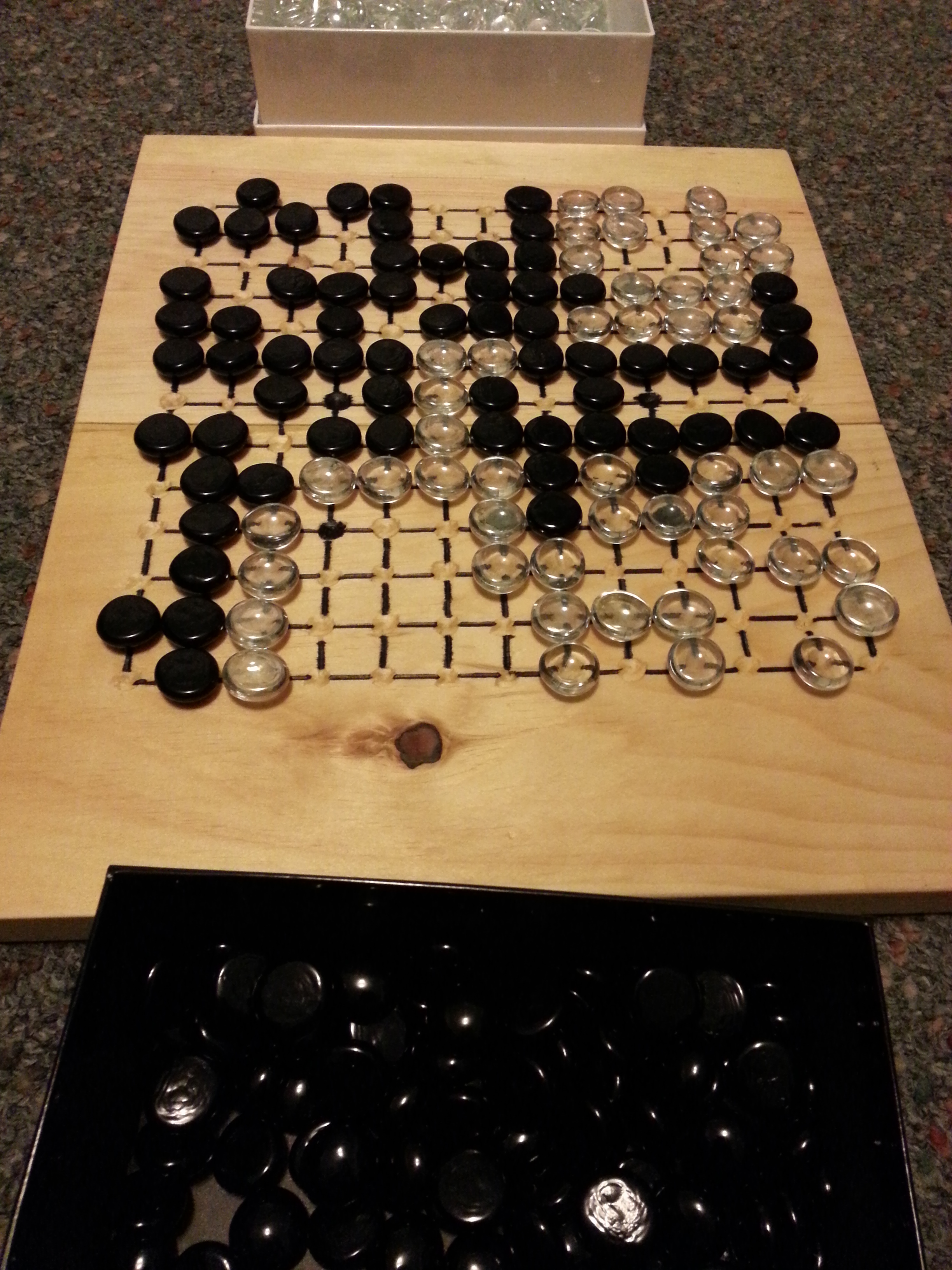Degrees of Go
Recently I started playing "Go" (known as baduk (바둑) in Korean and as wéiqí in Chinese). I started playing on an app on my phone, then made my own board (shown below).
Go is a fascinating game. It has very simple rules, but is very mathematically complex—even moreso than chess. In addition, it is really visually appealing (to me, anyway), played with simple black and white stones on an austere grid, on which a sort of irregular order emerges as the game progresses.

The basic concept of the gameplay is to surround your opponent's groups of stones while keeping your own stones from getting surrounded. The rules (Wikipedia is my main reference here) are:
- Stones are played on the intersection points of a grid (normally 19x19, 13x13, or 9x9)
- Black plays first (and may place more than one stone on his/her first move if a handicap is required)
- Connections (whether in groups or chains of your own stones or to surround an opponent's group) only matter in the cardinal directions along the grid lines
- If a stone or group of stones is surrounded (no empty intersections adjacent to it), it is captured
- A stone cannot be placed in a position with no empty intersections adjacent to it or the chain that it will join (i.e. in a position where it will immediately be captured—no "suicides"), unless it will capture an opponent's stone(s) and thus immediately open an adjacent intersection
- A stone cannot be placed in a position that would recreate the prior game state; this is to prevent endless cycles of "take-backs"
- A player can "pass" if they don't see any worthwhile moves; the game ends when both players pass successively
- Scoring is slightly different between national variations of the game, but one system (used in Korea and Japan) is that "a player's score is determined by the number of empty locations that player has surrounded minus the number of stones their opponent has captured"; often 6.5 points are added to White's score in compensation for Black's first move advantage
Wikipedia explains the rules/gameplay as follows:
Vertically and horizontally adjacent stones of the same color form a chain (also called a string or group) that cannot subsequently be subdivided and, in effect, becomes a single larger stone. Only stones connected to one another by the lines on the board create a chain; stones that are diagonally adjacent are not connected. Chains may be expanded by placing additional stones on adjacent intersections, and can be connected together by placing a stone on an intersection that is adjacent to two or more chains of the same color.
A vacant point adjacent to a stone is called a liberty for that stone. Stones in a chain share their liberties. A chain of stones must have at least one liberty to remain on the board. When a chain is surrounded by opposing stones so that it has no liberties, it is captured and removed from the board.
A key element to the game of Go is the concept of "Liberties": empty intersections adjacent to a stone or chain. Liberties that are surrounded by the same chain that they belong to are called "eyes". The opponent cannot place a stone into an eye unless every other liberty is already taken (due to the rule against "suicide"); this means that a group/chain of stones with two or more eyes is impossible to capture and will remain on the board for the duration of the game.
Mathematically, I think the game concept of "liberties" can be seen as degrees of freedom where stones could potentially be added on to an existing chain/group, or where the opponent must add constraints to capture a chain/group.
Because of the way that a stone's future status (kept on the board or removed) depends on the status of neighbouring points, I'm also reminded of the mathematical concept of cellular automata (like Conway's Game of Life) although they don't have continuing human input after the initial set-up. Go's adjacency rules follow the definition of a Von Neumann neighbourhood.
Here's the 13x13 Go board that I built:

Finally, here are the top ten reasons to play go, from the US Go Association.